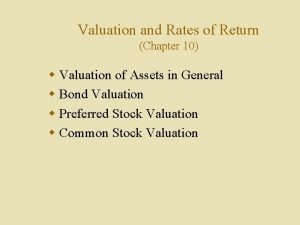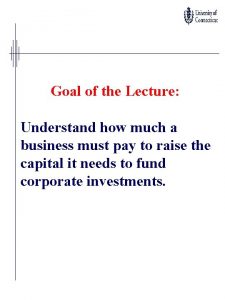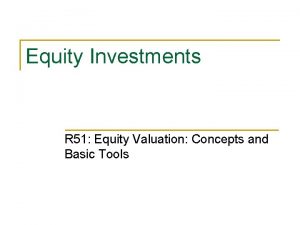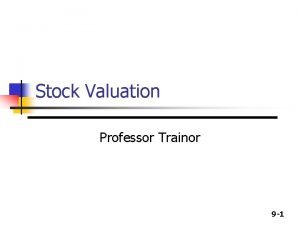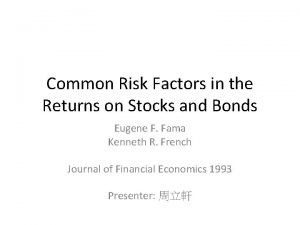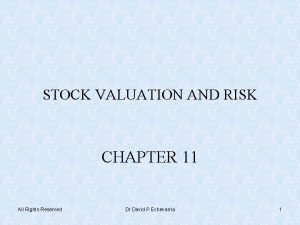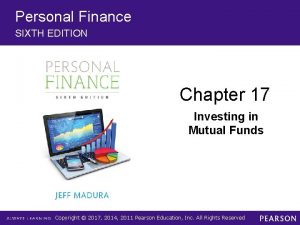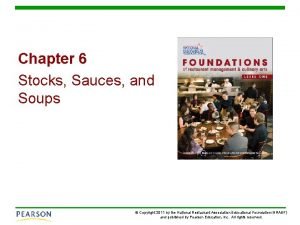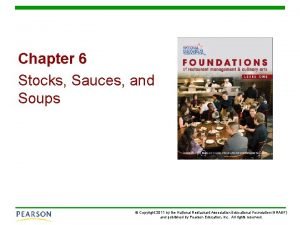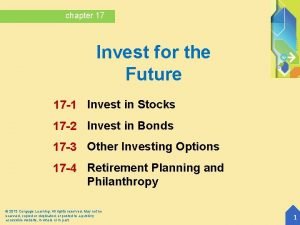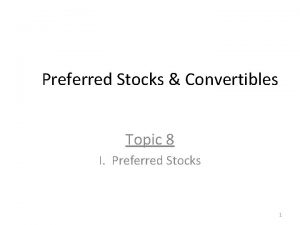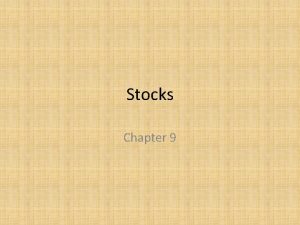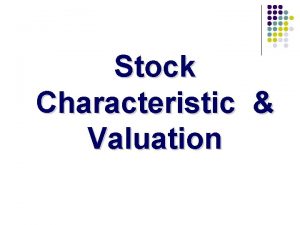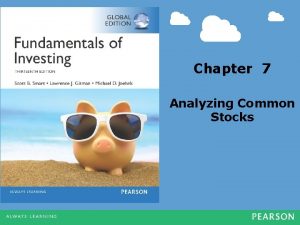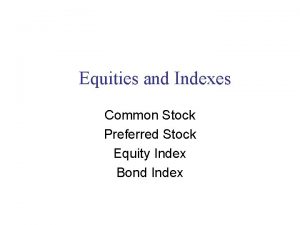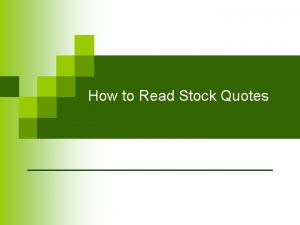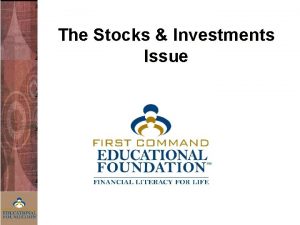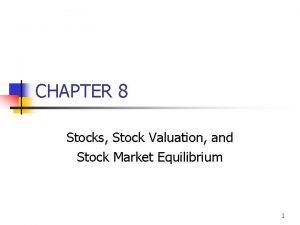CHAPTER 9 Stocks Section 1 Common Preferred Stock

















- Slides: 17

CHAPTER 9 Stocks

Section 1 – Common & Preferred Stock Common Stock is issued for companies to raise money Make & Sell Products Fund its operations Expand Investors buy stock because they want larger returns than savings accounts and bonds give They are willing to take more risk to get these gains Why do corporations issue stock? They issue stock to raise money, and that money does not need to be repaid – ever! Corporations can be one of two types Private Corporation – The stock is held by only a few individuals (<100) Do NOT have to report earnings, other statistical information Public Corporation – The stock is held by many individuals (>100, but usually in the millions) Do have to report earnings, reports, etc. CHAPTER 9 - STOCKS

Why do investors buy Common Stock? 1. Income From Dividends “Profit Sharing” – Company pays shareholders a certain amount of money per share held. These are typically paid quarterly. Can either be a fixed amount or a percentage of the value of the stock 2. Appreciation of Stock Value If the perceived value of the company goes up, the value of the stock could rise. You could sell it for profit in the future, as long as the business is doing well. A company that re-invests its profits, rather than paying them out as dividends may have larger increases in value (called a “growth” stock) 3. Increased Value from Stock Splits Shares get divided up, so your 1 share may become 2 shares (or 7, or 10!) Companies split stock, so that the price of a single share stays in a certain range. CHAPTER 9 - STOCKS

4. Voting Rights Owning shares of stock gives you the ability to vote on what that company does. If you own 20% of the outstanding stock, you have 20% of the vote. If you bought 50. 1% of the stock or more, you could completely control the company Pre-Emptive Right – Current owners of stock have the right of “first buy” when new stock is issued, so that they can keep their percentage of ownership the same. Preferred Stock Gives the holder the right to dividend before common stock holders Usually only an issue if a company is struggling Par Value – Assigned dollar value of stock Dividends are paid based on this amount Even if stock price goes up, this value will not change CHAPTER 9 - STOCKS

Why do companies issue preferred stock? Attracts more conservative investors Attracts larger investors, people who are buying 10%, 20% of company Why do investors purchase preferred stock? It’s a “middle investment” Generally a little lower earnings than stocks, yet still higher than bonds Their growth potential is lower than common stock (means less risk) CHAPTER 9 - STOCKS

Section 2 - Evaluating Stocks Types of Stock Investments 1. Blue Chip Stocks Safer, conservative investment Large, strong, respected, well-established companies Generally pays dividends AT&T, Walmart 2. Income Stocks Large companies Pay higher than average dividends Conservative Investment Chevron, Edison, Mc. Donalds CHAPTER 9 - STOCKS

3. Growth Stocks Potential Earnings are higher than average Riskier investment Companies that have high sales, high revenue, and new, innovative products Apple, Disney, Qualcomm 4. Cyclical Stocks Tend to reflect the market as a whole When market is up, they are up. Market is down, they are down Ford, GM, Caterpillar 5. Defensive Stocks Tends to remain stable, even in times of economic decline Tend to offer products that people will need to buy no matter what Pepsico, Proctor & Gamble, Walmart CHAPTER 9 - STOCKS

6. Large Capitalization Stocks (Large Cap) Capitalization is the total amount of outstanding stock issued by a company Large Cap stocks are companies that have more than $5 billion dollars in outstanding stock Tend to be safe, conservative, investments 7. Mid Capitalization Stocks (Mid Cap) Between $2 billion and $10 billion Medium risk, growth companies are usually here 8. Small Capitalization Stocks (Small Cap) Between $50 million and $2 billion Riskier stocks Lots of growth potential, but could fail as well. Many of these companies are “bought out” by larger ones as they grow CHAPTER 9 - STOCKS

9. Micro-Cap Stocks The smallest companies. Less than $100 million in capitalization Enormous growth potential, but very good chance at failure Extremely risky investment 10. Penny Stocks that trade for under $1 a share Either new companies, or companies that are struggling Very, very risky Sometimes information is limited, so caveat emptor – ‘buyer beware’ CHAPTER 9 - STOCKS

Factors that affect the price of stocks 1. Overall stock market Bull market – “charging forward” Investors are optimistic, prices are generally rising Even a company doing poorly might be “dragged” along with the market Bear market – “Bear/Bare” Investors are pessimistic, prices are generally declining A well performing company by be dragged down Correction – when the market “resets” itself, because prices rose too much HEALTHY AND NORMAL!!! The ratio of Bull Markets: Bear Markets tends to run about 5: 1, where have about 5 times as many years in a Bull Market as you do in a Bear Market. CHAPTER 9 - STOCKS

2. Individual Stock Measures Current Yield Dividend Amount divided by Total Price If stock price rises, yield goes down Total Return Annual Dividend plus increase in stock price Earnings per Share (EPS) Net Earnings of the company divided by total shares outstanding CHAPTER 9 - STOCKS

Price-Earnings Ratio (P/E Ratio) Price of one share divided by Earnings per Share In general, the higher the P/E ratio, the more you have to invest to make money A low P/E ratio might mean the company is undervalued (great buy!) or ready to collapse (bad buy!) Historically, the P/E ratio for the entire market has been between 15 -25 When it hits about 30, the market tends to “reset” or “correct” itself, lowering stock prices, while not affecting earnings, which reduces their P/E ratios Current P/E ratio of the S & P 500 is 22. 95 Was around 12 after the “crash” of 2008/2010 CHAPTER 9 - STOCKS

Investment Theories The Fundamental Theory A stock’s real value is determined by looking at future earnings The Technical Theory A stock’s value is determined by forces in the stock market itself Shares traded, total stocks purchased, etc The Efficient Market Theory A stock’s value is random. Since all investors have considered all information, no investor can outperform market over a long period of time CHAPTER 9 - STOCKS

Section 3 – Buying and selling stocks Usually would purchase through a brokerage firm, or through your 401(k)/403(b) Two markets to purchase from 1. Primary market Purchase of newly issued securities, directly from the investment bank IPO – Initial Public Offering, first time a stock is being sold to the general public You will probably NEVER purchase stock on the primary market 2. Secondary Market Once they’ve been sold on the primary market, this is where all stocks are sold and traded Securities Exchanges NYSE – New York Stock Exchange There are other regional (San Francisco, Chicago) and National (Tokyo, London, etc) exchanges OTC (Over the Counter) Market NASDAQ – computer system that regulates the trading of securities. CHAPTER 9 - STOCKS

How to buy and sell 1. Brokerage Firm Full-service, Discount, Online – based on your level of expertise and what you want to pay 2. Account executive A person who works for the brokerage firm that manages your portfolio of securities Buys and sells on your behalf, either with or without your knowledge (depends on what you want) Types of stock orders Market Order Request to buy or sell a stock at the current market price Limit Order Request to buy or sell a stock at a specific price Stop Order Request to sell a stock when the price drops to a particular value (to save from losses) CHAPTER 9 - STOCKS

Investment Strategies Long Term Strategies – HIGHLY RECOMMENDED 1. Buy & Hold onto the stock for a long time, allowing the price to “smooth” out over time 2. Dollar Cost Averaging Buying an equal value of stock over many purchases When price is high = less shares When price is low = more shares Helps prevent overbuying when overpriced, and underbuying when underpriced This is probably going to happen automatically using payroll deductions to pay for your stocks 3. Dividend Reinvestment plans Dividends are automatically reinvested to purchase more shares (rather than cashing them out) If a company pays a 3% dividend and you reinvest it, you can double your shares in 24 years. This is above and beyond the stock price increasing CHAPTER 9 - STOCKS

Short Term Techniques – RISKY!!! ONLY IF PROFESSIONAL AND YOU KNOW WHAT YOU’RE DOING 1. Buying on Margin Borrowing money so that you can purchase more shares Have to repay the money later when you sell the stock If the price goes up, you make a little more money If the price goes down, you lose a LOT more money 2. Selling Short Making money when the price of a stock goes down… Wait… what? Here’s how it works. 1. Borrow shares 2. Sell borrowed shares 3. Buy new shares when the price drops 4. Replace borrowed shares with newly bought ones. CHAPTER 9 - STOCKS
 Long-term debt preferred stock and common stock
Long-term debt preferred stock and common stock Characteristics of bonds
Characteristics of bonds Well behaved preferences
Well behaved preferences Preferred stock formula
Preferred stock formula Formula for preferred stock
Formula for preferred stock Wacc preferred stock
Wacc preferred stock 51 equity
51 equity Cost of preferred stock
Cost of preferred stock Preferred stock valuation
Preferred stock valuation Classroom stock market game
Classroom stock market game Common risk factors in the returns on stocks and bonds*
Common risk factors in the returns on stocks and bonds* A flavorful liquid made by gently simmering bones
A flavorful liquid made by gently simmering bones Dr david echevarria
Dr david echevarria Chapter 17 investing in stocks
Chapter 17 investing in stocks Chapter 6 stocks sauces and soups
Chapter 6 stocks sauces and soups Chapter 6 stocks sauces and soups
Chapter 6 stocks sauces and soups Chapter 6 stocks sauces and soups
Chapter 6 stocks sauces and soups 17 invest
17 invest



